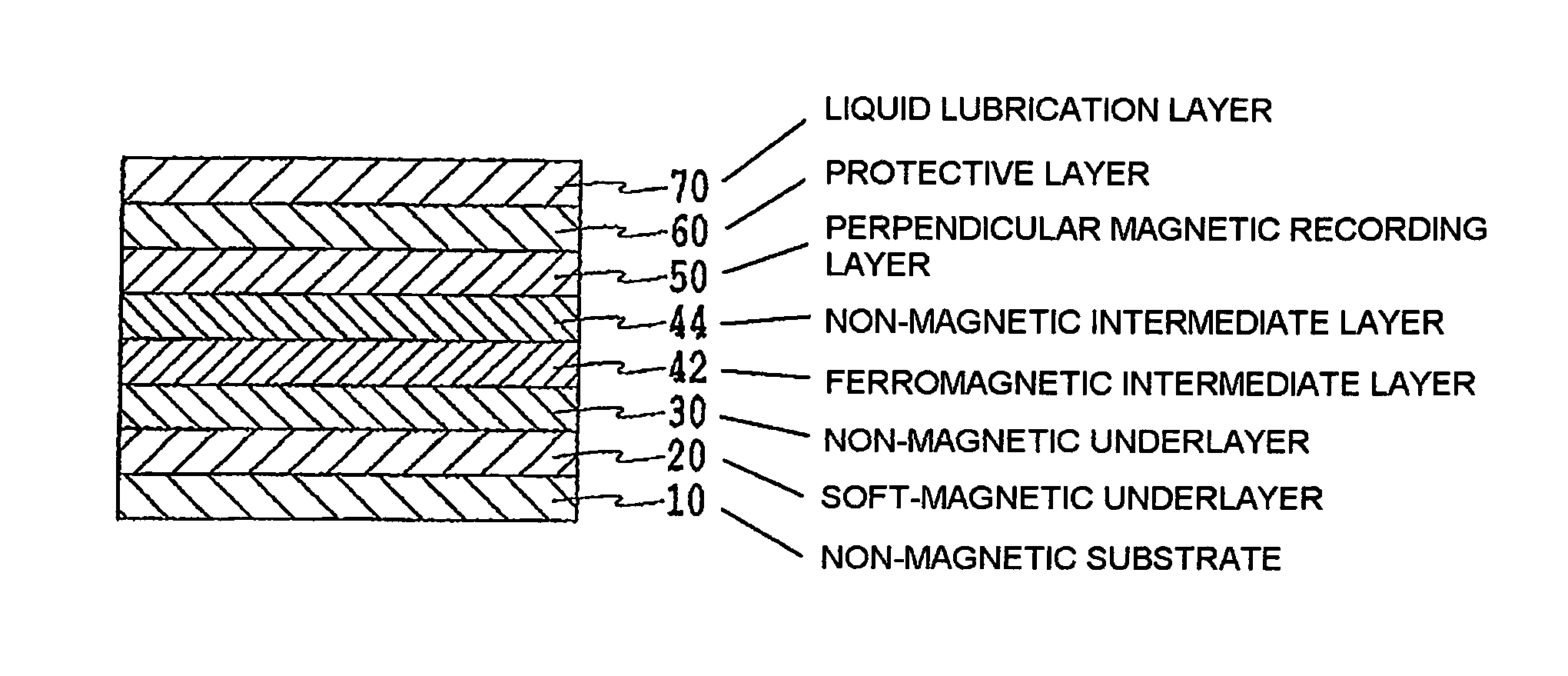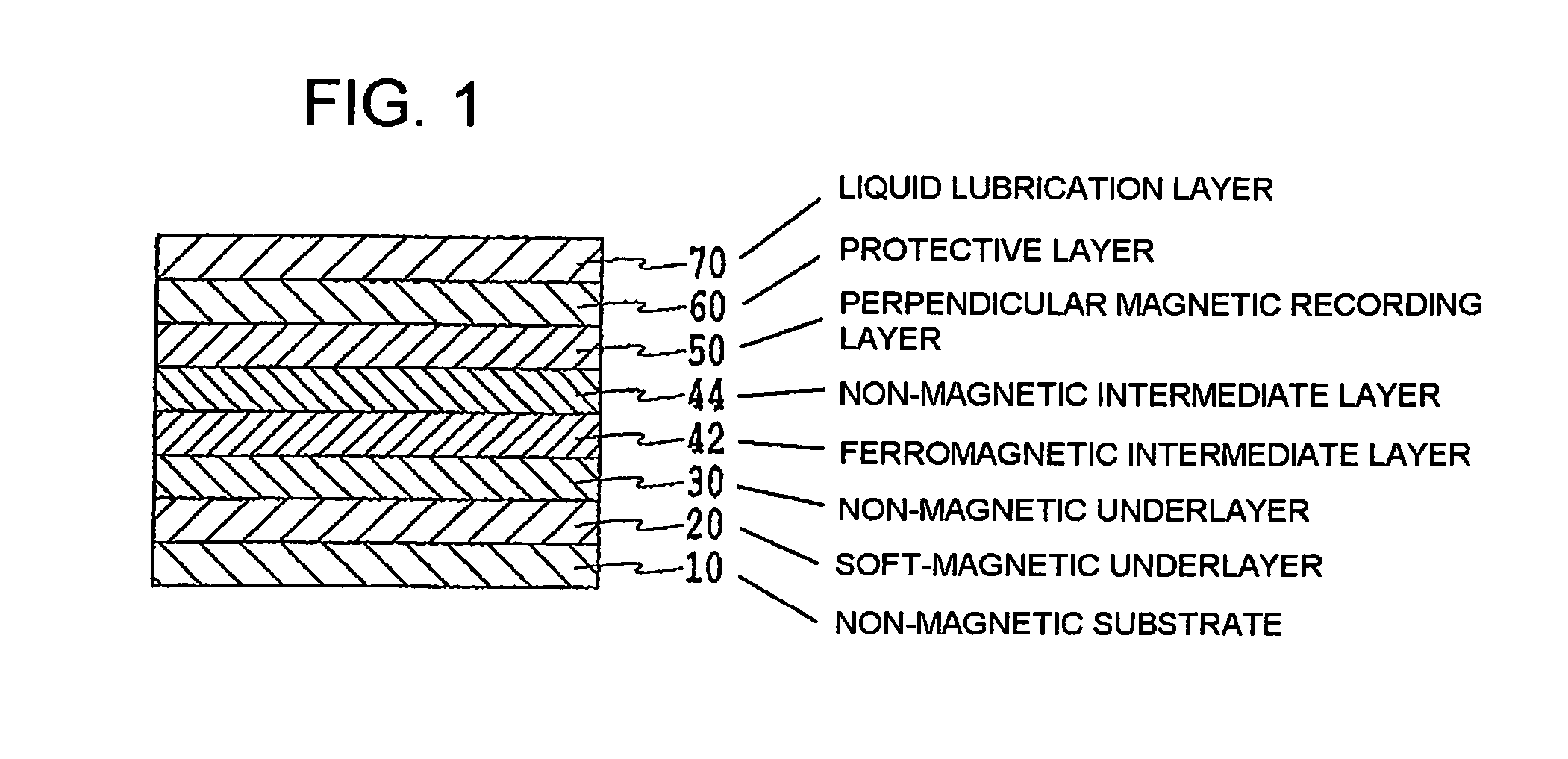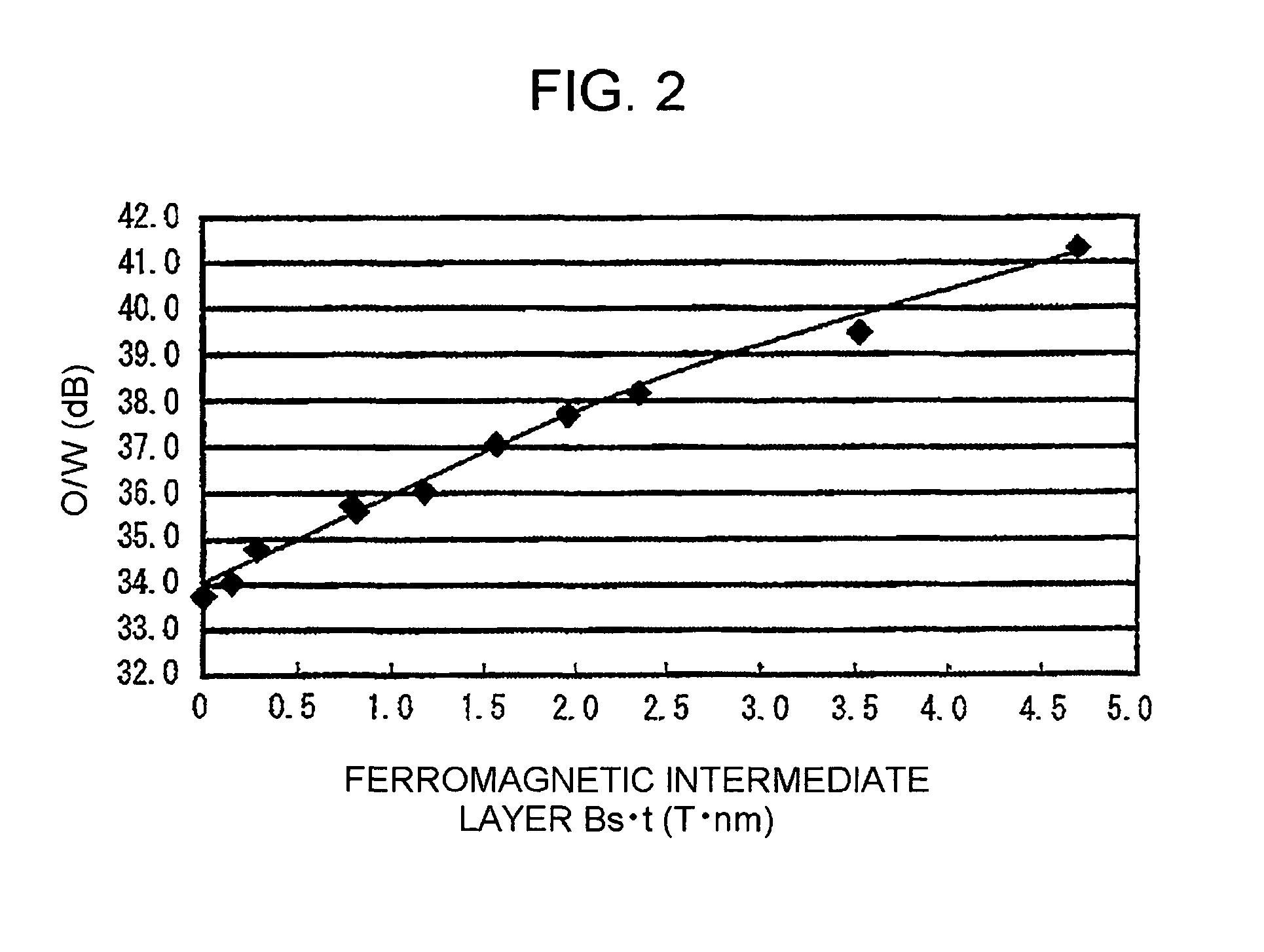Perpendicular magnetic recording medium
a magnetic recording medium and perpendicular technology, applied in the field of perpendicular magnetic recording medium, can solve the problems of increasing noise, increasing orientational dispersion, and reducing signal output, so as to reduce the effective film thickness of the non-magnetic intermediate layer, improve writability, and reduce the effect of medium nois
- Summary
- Abstract
- Description
- Claims
- Application Information
AI Technical Summary
Benefits of technology
Problems solved by technology
Method used
Image
Examples
example 1
[0041]A chemically reinforced glass substrate with a smooth surface (a HOYA N-5 glass substrate) is cleaned, and used as the non-magnetic substrate 10. The non-magnetic substrate 10 is introduced into a DC magnetron sputtering device and, using a Co3Zr5Nb (configured of 3% Zr, 5% Nb, and the remainder Co, with the total number of atoms as a reference; the same applying hereafter) target in an Ar gas at a pressure of 0.67 Pa, the CoZrNb amorphous soft-magnetic underlayer 20 with a film thickness of 40 nm is deposited. Next, using a Ni25Cr target in an Ar gas at a pressure of 0.67 Pa, the Ni25Cr non-magnetic underlayer 30 with a film thickness of 6 nm is deposited. The Ni25Cr film obtained is non-magnetic, and has an fcc structure.
[0042]Next, using a Co25Cr target in an Ar-4% N2 gas at a pressure of 0.67 Pa, the Co25Cr ferromagnetic intermediate layer 42 with a film thickness of 2 nm is deposited. Herein, the saturation magnetic flux density Bs of the Co25Cr ferromagnetic intermediate...
examples 2 to 6
, Comparison Examples 1 and 2
[0045]In each example, the total film thickness of the Co25Cr ferromagnetic intermediate layer 42 and the Co35Cr film which is the lower layer of the non-magnetic intermediate layer 44 is fixed at 12 nm. Except that the film thicknesses of the Co25Cr ferromagnetic intermediate layer 42 and Co35Cr film are changed as shown in Table 1, the perpendicular magnetic recording media are obtained by repeating the procedure of Example 1. The product Bs·t of the saturation magnetic flux density Bs and film thickness t of the Co25Cr ferromagnetic intermediate layer 42 is also shown in Table 1.
[0046]
TABLE 1Film thickness and Bs · t of ferromagnetic intermediatelayer 42, and film thickness of lower layer of non-magneticintermediate layer 44FerromagneticNon-magneticIntermediateIntermediate LayerFerromagneticLayer 42 (Co25Cr)44 Lower LayerIntermediateFilm Thickness(Co35Cr) FilmLayer 42 Bs · t(nm)Thickness (nm)(T · nm)Example 12100.78Example 2391.17Example 3481.56Exampl...
examples 7 to 9
[0047]In each example, except that (a) a ferromagnetic intermediate layer 42 configured of a CoCr alloy wherein the relative proportion of Cr is changed from 28% of the atoms to 32% of the atoms and having a film thickness of 12 nm is formed, and (b) the Co35Cr film of the lower layer of the non-magnetic intermediate layer 44 is omitted, and the non-magnetic intermediate layer 44 is made a single-layer film having a film thickness of 8 nm, the perpendicular magnetic recording media are obtained by repeating the procedure of Example 1. The composition of the CoCr ferromagnetic intermediate layer 42, the saturation magnetic flux density Bs, and the product Bs·t of the saturation magnetic flux density Bs and film thickness t are shown in Table 2.
[0048]
TABLE 2Composition of ferromagnetic intermediate layer 42,saturation magnetic flux density Bs, and Bs · tFerromagnetic IntermediateLayer 42 CharacteristicsSaturationMagnetic FluxCompositionDensity Bs (T)Bs · t (T · nm)Example 7Co28Cr0.068...
PUM
| Property | Measurement | Unit |
|---|---|---|
| thickness | aaaaa | aaaaa |
| thickness | aaaaa | aaaaa |
| thickness | aaaaa | aaaaa |
Abstract
Description
Claims
Application Information
 Login to View More
Login to View More - R&D
- Intellectual Property
- Life Sciences
- Materials
- Tech Scout
- Unparalleled Data Quality
- Higher Quality Content
- 60% Fewer Hallucinations
Browse by: Latest US Patents, China's latest patents, Technical Efficacy Thesaurus, Application Domain, Technology Topic, Popular Technical Reports.
© 2025 PatSnap. All rights reserved.Legal|Privacy policy|Modern Slavery Act Transparency Statement|Sitemap|About US| Contact US: help@patsnap.com



